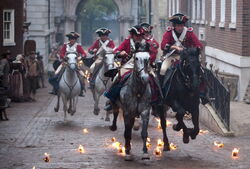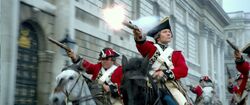
- "I’ll need a horse... or maybe two horses."
"You’re in luck, sir. Two horses happen to be what I have available. The bay gelding and the chestnut gelding." - ―Jack Sparrow and the horse livery manager
The horse is a four-legged, one-toed, hoofed mammal with a flowing mane and tail. Although some live in the wild as feral horses, humans began domesticating horses since ancient times. Humans provided horses with food, water, and shelter as well as attention, while also using them for riding and for drawing carriages or carrying loads. Horses were also used in warfare, from which a wide variety of riding and driving techniques developed, using many different styles of equipment and methods of control.
History
- "Damn! Bloody horse. Nice horsey. C’mere, you scurvy nag."
"Stop that, you fool! Don’t you know anything? You run, the horse runs! And he can run a lot faster than you!" - ―Jack Sparrow and Ayisha
Over millions of years, the horse evolved from a small multi-toed creature into a large, single-toed animal. Horses have been domesticated since ancient times, although some domesticated populations live in the wild as feral horses. Humans provided horses with food, water, and shelter as well as attention, while also using them for riding and for drawing carriages or carrying loads. Horses were also used in warfare, from which a wide variety of riding and driving techniques developed, using many different styles of equipment and methods of control.
In Greek mythology, the Trojan Horse was a huge wooden horse said to have been constructed and used by the Greeks during the Trojan War to enter the city of Troy and win the war. Metaphorically, a "Trojan horse" has come to mean any trick or stratagem that caused a target to invite a foe into a securely protected bastion or place.[1][2]
During his time as a merchant captain for the East India Trading Company, Jack Sparrow was unfamiliar with horses, and encountered much difficulty when he found himself needing to ride a horse named Caesar in the port of Calabar.[3]

The Bit 'n' Stirrup supplied bits, bridles, and lots of other equipment for Port Royal's horses, including those used by the soldiers of the garrison stationed at Fort Charles.[4] Prior to Captain James Norrington's promotion ceremony, Governor Weatherby Swann and his daughter Elizabeth left their mansion in a horse-drawn carriage which made its way toward Fort Charles, where Norrington's ceremony was to take place. During the attack on Port Royal by the Black Pearl, one of the soldiers' horses became frightened as cannonballs battered the stone walls of the fort, destroying the gallows in the courtyard.[1] One year later, when the East India Trading Company arrived in Port Royal, Lord Cutler Beckett sailed to shore astride a white horse in a longboat.[5] Later, Governor Swann broke his daughter, Elizabeth, out of prison and hastily drove a horse-drawn carriage to the waiting ship, Terpsichore. As they neared the dock, the governor slowed his horses to a stop as he saw Captain Hawkins killed by Mercer.[6]

In London, England, to effect the rescue of Joshamee Gibbs, Captain Jack Sparrow arranged for the driver of a paddy wagon to take them outside of Londontown, horses waiting, where they would make the coast that night. Following Joshamee's trial, Jack plucked his tricorn hat off the head of a horse that was hitched to the paddy wagon, which ultimately took Sparrow and Gibbs to St. James's Palace.[7] While making his escape in London's streets, Jack swings down from the palace into a Society Lady's lap before climbing out onto the roof of the horse-drawn carriage and straddled between two carriages. Jack was forced to push the driver aside a slow-moving coal wagon, then snaps the reins, but the horses don't respond as the Captain of the Royal Guard and his men chase the notorious pirate on horseback behind him. After the Guards aim and shoot, hitting a lantern mounted on the side of the wagon, lighting the coal, the horses leap forward, frightened. The flaming cart races beneath an arch, pursued by soldiers on horseback as it careens down the street.[8]

During the bank robbery in the island of Saint Martin, Captain Jack Sparrow's motley crew of pirates tied two ropes to a vault that ran through two holes of the bank that were attached to three teams of horses that stood at the ready behind the bank. As the guards opened fire and bullets flew, the horses let out nervous whinnies and started to prance at the end of their harnesses in the back of the bank. A few reared up, chomping on their bits, and they tried to move away from the building and noise. Inside the bank, the ropes attached to the horses grew taught as the vault began to slid across the floor and slammed hard into the back wall. As the horses were straining hard against their harnesses, the pirates struggled to keep control of large animals. At the same time the guards fired again, the horses pulled forward with all their might to get away from the terrifying sound. The horses had then pulled the entire building completely free of its foundation, with Jack Sparrow finding himself being dragged behind the now-mobile bank through the streets of Saint Martin. With each volley of gunfire from guards that continue to fire behind them, the horses went faster, frothing at their mouths, with their sides heaving.[9][10]
Later, during the executions of Carina Smyth and Jack Sparrow at Saint Martin, Jack's crew fired a cannon, sending a group of horses scattering in the town square. The horses raced forward, running right at the guillotine which Sparrow was to be executed from. Seeing the horses move toward him, Jack struggled to get out of the way, but there was nowhere for him to go. Once again, he waited for his inevitable death, this time at the hands—or rather, hooves - of the horses. But the moment never came as the horses slammed into the side of the guillotine, sending it crashing to the other side, setting Jack free.[9][10]
Behind the scenes
A former vignette in Walt Disney's Pirates of the Caribbean attraction depicted a hungry pirate caught between a horse and a goat, but was removed during the 2006 refurbishments.[citation needed]
Lord Cutler Beckett's arrival at Port Royal at the beginning of Pirates of the Caribbean: Dead Man's Chest, mounted on his horse aboard a rowboat, was taken from an idea screenwriters Ted Elliott and Terry Rossio had for The Mask of Zorro. Don Rafael Montero, the villain in Zorro, was to be introduced mounted on his horse aboard a rowboat, but the idea was considered "too expensive" and was scrapped. For Dead Man's Chest, Elliott and Rossio thought they'd try again to include the introduction of a character riding to shore on a horse in a boat. First they tried to cut it because it was too unbelievable, with the note from a historian was, "Riding on a horse in a small boat is suicidal! It would never be done!" Then they tried to cut it for budget reasons, but director Gore Verbinski opted to use the idea for Beckett's introduction in Dead Man's Chest.[11][12]
Appearances
- Walt Disney's Pirates of the Caribbean (First appearance)
- Jack Sparrow: The Coming Storm (Mentioned only)
- The Price of Freedom
- Legends of the Brethren Court: The Turning Tide (Mentioned only)
- Pirates of the Caribbean: The Curse of the Black Pearl (First identified as horse)
- Pirates of the Caribbean: Dead Man's Chest
- Pirates of the Caribbean: On Stranger Tides
- Pirates of the Caribbean: Dead Men Tell No Tales
- The Secret of Galileo's Diary
- Pirates of the Caribbean: Dead Men Tell No Tales Novelization
- Pirates des Caraïbes : La Vengeance de Salazar
Sources
External links
Notes and references
- ↑ 1.0 1.1 Pirates of the Caribbean: The Curse of the Black Pearl
- ↑ Pirates of the Caribbean: The Curse of the Black Pearl (2006 junior novelization)
- ↑ The Price of Freedom, Chapter Nine, Ayisha
- ↑ Pirates of the Caribbean: The Complete Visual Guide, p. 17
- ↑ Pirates of the Caribbean: The Complete Visual Guide, p. 44
- ↑ Pirates of the Caribbean: Dead Man's Chest
- ↑ Pirates of the Caribbean: On Stranger Tides (junior novelization)
- ↑ Pirates of the Caribbean: On Stranger Tides
- ↑ 9.0 9.1 Pirates of the Caribbean: Dead Men Tell No Tales
- ↑ 10.0 10.1 Pirates of the Caribbean: Dead Men Tell No Tales Novelization
- ↑ Pirates of the Caribbean: Dead Man's Chest - Audio Commentary with Screenwriters Ted Elliott & Terry Rossio
- ↑ Wordplayer.com: WORDPLAY/Archives/"Caribbean Tales" by Terry Rossio